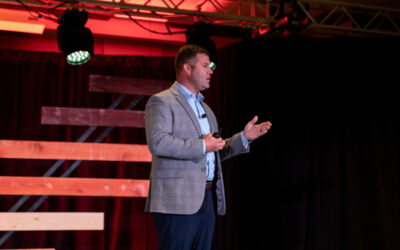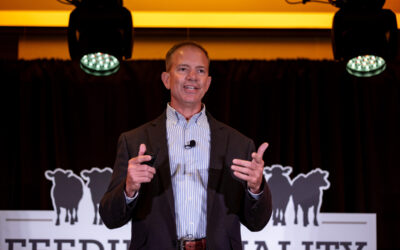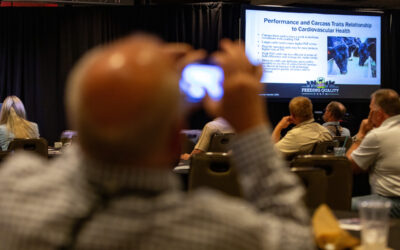
Feeding Quality Forum challenges norms
More than 200 hear from marketing experts, animal scientists
By Miranda Reiman
If you think you have the cattle feeding business all figured out, you’re probably mistaken.
That’s according to speakers at the Feeding Quality Forum in Grand Island, Neb., and Amarillo, Texas, last week. The experts addressed what they “used to know” that’s no longer so.
“After decades of slow change, the North American cattle and beef industries are undergoing rapid transition,” said Pete Anderson, director of research for Midwest PMS, at the event that drew more than 200 at the two locations.
In the last 25 years, the use of expected progeny differences (EPDs) have allowed Angus birth-weight trends to remain flat while growth continued upward, Anderson noted.
Quality improved at the same time, but that had to mean more than just grading Choice.
“The difference between Choice and Select is no longer the distinction of quality; it’s between Choice and the branded programs,” he said.
Cattlemen on this continent are best positioned to exploit that shift if they can maintain their recent focus.
“North America must stay in and dominate the world high-quality beef market,” Anderson said. “Exports are key.”
Dan Basse, president of AgResource Company, also noted the significance of the U.S. as the leading source of corn-fed, high-quality beef. But he warned that the rest of the world is catching up: “We’ll see the shift, more grain being fed and more focus on marbling and quality than before. That differentiation will be diminished.”
The market analyst made those comments as part of his overview of global factors affecting U.S. agricultural markets this year.
World-wide corn, soybean and wheat yields will be strong, he said, predicting 547 million metric tons for the combined harvest.
But that doesn’t necessarily mean he’s bearish on prices.
“It’s not as bad as we thought this time around. This time, we not only have big crops, but we also have big demand,” he said.

Weather challenges abroad and strong export demand explain part of the picture. If corn price dips below $3.25/bushel, feeders should lock in prices, Basse said. However, he did not recommend hedging fed cattle.
“As we think about [Chicago Mercantile Exchange] futures, they’re too cheap relative to our modeling. The fourth quarter, we think it’s about $10 too cheap, relative to where the market should be today,” he said.
During the past few years of “expensive” corn, economists predicted carcass weights would tail off as feeders struggled to cut feed costs. That didn’t happen, said Robbi Pritchard, South Dakota State University animal scientist.
He addressed the question, “When are your cattle done,” though of course there is no set answer. He said the old rule was to sell finished cattle before their feed-to-gain ratio tanked.
“Energetic inefficiency is not what it used to be,” Pritchard said, noting genetics and technology have changed. Big cattle are not automatically inefficient cattle, but they do require different management.
“We have to feed to higher growth potential or they won’t grade,” he said.
Yet, adding days on feed and carcass weight creates challenges from the packing plant to the consumer.
“The high school kid who can eat a 16-ounce steak can’t afford to buy it,” he joked. “What’s my definition of done supposed to be? When I make the most money, or when I create the right product?”
Indeed, the cattle of the 1950s are drastically different than those of this century, but they’re still valued on equations developed more than 50 years ago and based on data from 162 head, said Ty Lawrence, West Texas A&M meat scientist.

“Those five loads of cattle determine what we now use as the USDA yield grade equation,” he said. Data shows that the yield equation could benefit from tweaking to more accurately predict cutability.
“We have revised the guidelines of how to feed cattle seven times, but have never revised how we estimate red meat yield,” he said, referencing the Nutrient Requirements of Beef Cattle.
Robin Falkner, managing veterinarian with Zoetis beef technical services, said that’s not the only part of the cattle business that deserves a second look.
“Just because we’ve been doing something for 100 years, doesn’t mean it’s right,” he said.
Getting prepared for the Veterinary Feed Directive (VFD) is simply a good chance to evaluate details like transportation and placement protocols and pen size.
“Health solutions don’t come in a bottle, aqueous solutions do,” said the veterinarian, challenging the group to think creatively. “Stockmen offer management solutions.”
So do educators.
Larry Corah, former Kansas State University (K-State) animal scientist and long-time Certified Angus Beef LLC (CAB) vice president, received the forum’s Industry Achievement Award during a lunch program.
“A branding iron is designed to leave a mark, and through his career, Dr. Larry Corah has left his mark on the cattle feeding industry,” said CAB vice president of supply Mark McCully, at the Amarillo meeting. McCully presented his mentor with branding irons featuring the CAB logo and K-State’s “Flying K.”
The meetings were co-sponsored by Zoetis, Roto-mix, Feedlot magazine, Micronutrients and CAB. To view presentations and summary information, visit www.feedingqualityforum.com.
You may also like
Consumer Demand, Power of Quality
Demand for high-quality beef persists. But with that demand comes challenges. From tight cattle supplies to higher costs and increasing pressure on retailers to deliver a consistent eating experience, the pressure is on. David O’Diam, CAB VP of retail, addressed the current retail beef environment, highlighting both opportunities and challenges in today’s marketplace.
Data-Driven Progress and Partnerships
Discussions at Feeding Quality Forum reaffirmed the industry’s commitment to quality, transparency and innovation. With record Prime rates and strong consumer demand, producers who invest in genetics, health and relationships are positioned to drive progress and capture premiums.
Better Cattle Bring Opportunity
Cattle keep getting better, but that doesn’t mean producers should slow down progress. That’s what attendees took home from the 2025 Feeding Quality Forum. It’s call to action for the entire beef industry. Better cattle, yet new and old challenges for each segment.



